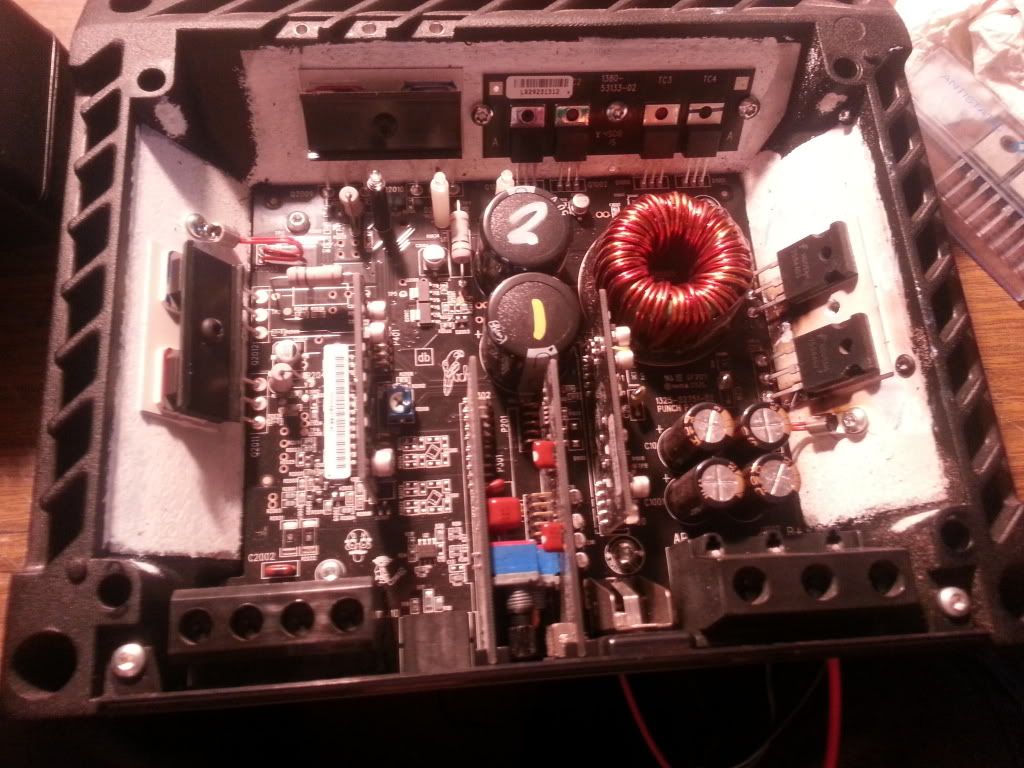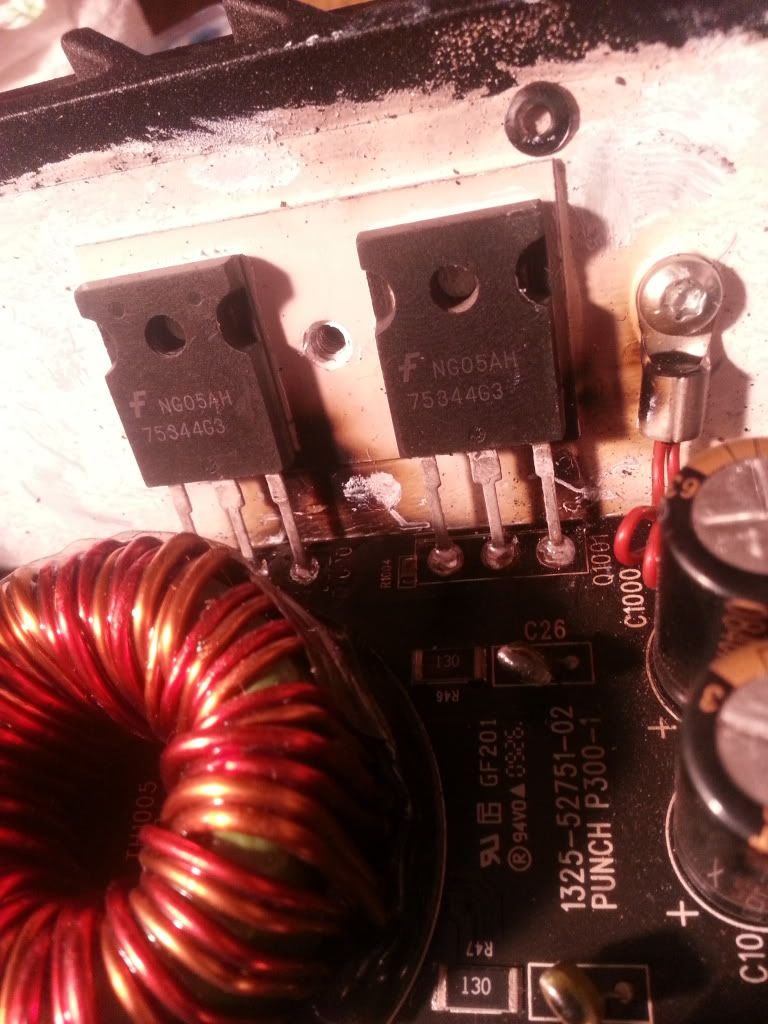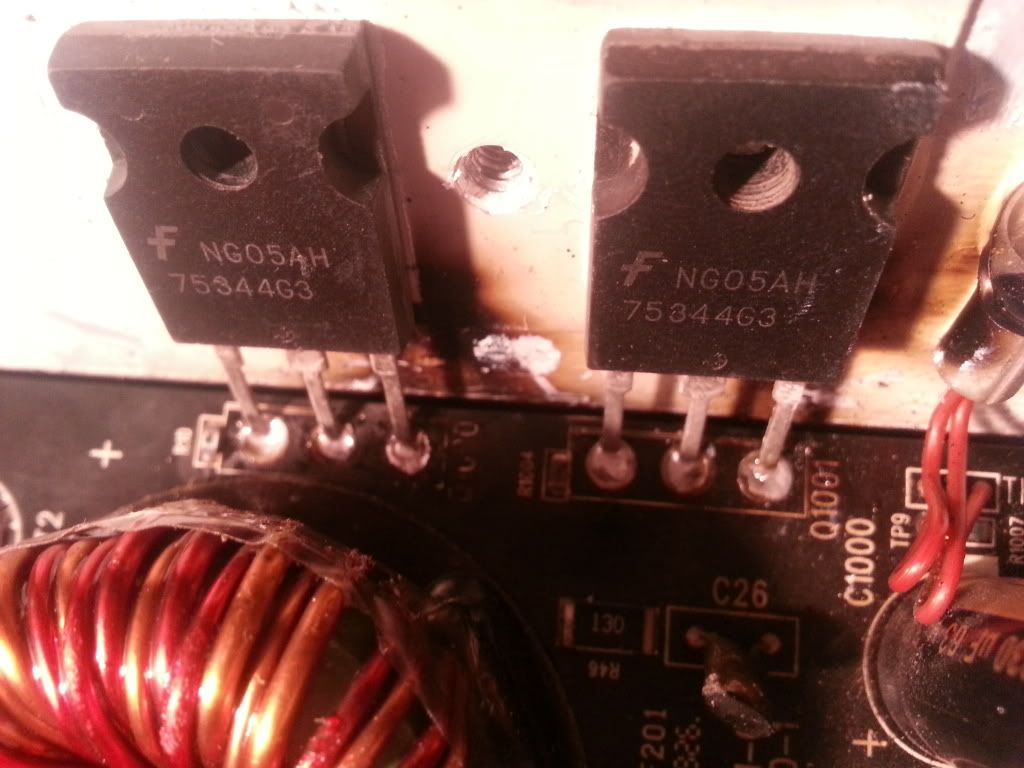Hello all,
I received two amps from a friend asking me to see if i could fix them. He got them from a yard sale and knows nothing about them besides them not working. They are RF P300-1/2. Both of them have the same visible issue, blown fets. For simplicity sakes ill be referring to the p300-1 amp.
Im still in the process of gathering more knowledge on amp repair and am to a point of confusion and having trouble finding information(or possibly searching for the wrong things) so i decided to stop by here.
The visible issues that are immediately noticed are the larger fets located nearest the B+ terminal. Both of them had completely blown and lost a leg.
I replaced them and attempted to connect the amp. Upon connection the power light flickers, i hear a scratching, fuzzing sound from one of the components but cannot figure which one and the replaced fet gets really hot.
I know this is fairly vague and need to learn more, but hoping stopping by here can get me in the right direction before i waste much more time searching wrong terms, parts etc... Any information is much appreciated. Thank you
Pictures show the fets that were previously blown(you can see the markings around them)



I received two amps from a friend asking me to see if i could fix them. He got them from a yard sale and knows nothing about them besides them not working. They are RF P300-1/2. Both of them have the same visible issue, blown fets. For simplicity sakes ill be referring to the p300-1 amp.
Im still in the process of gathering more knowledge on amp repair and am to a point of confusion and having trouble finding information(or possibly searching for the wrong things) so i decided to stop by here.
The visible issues that are immediately noticed are the larger fets located nearest the B+ terminal. Both of them had completely blown and lost a leg.
I replaced them and attempted to connect the amp. Upon connection the power light flickers, i hear a scratching, fuzzing sound from one of the components but cannot figure which one and the replaced fet gets really hot.
I know this is fairly vague and need to learn more, but hoping stopping by here can get me in the right direction before i waste much more time searching wrong terms, parts etc... Any information is much appreciated. Thank you
Pictures show the fets that were previously blown(you can see the markings around them)



Did you check/replace the gate resistors (R10 and R1004)?
Sometimes the driver transistors (Q103 and Q104) on the power supply driver board fail but that's not as likely to happen on an amp with only 2 power supply FETs.
Did you check the output transistors?
Sometimes the driver transistors (Q103 and Q104) on the power supply driver board fail but that's not as likely to happen on an amp with only 2 power supply FETs.
Did you check the output transistors?
I have not checked them, will definitely look into this. Thank you! I did notice the adapter/power supply I was attempting to use was putting out 19.3v ... dont think thats a good thing.. so i have a few things to look into. Im not quite familiar with all this, but ill learn me some things. Thanks for pointing me in a direction!
Rockford amps won't operate above 16v so you'll have to find a better 12v power supply to test it after replacing the damaged components.
So ive managed to secure a new supply (Just for testing purposes of course) that is a CPU power supply. it can handle 15amps and 400w. Im just trying to get the thing to stay on, i will not be putting load to this supply. I do understand that this isnt a great solution, but was trying to find a solution that will allow me to test without having to go plug it up to the car battery every time. So with that said, i have everything wired and the PSUon, the B+ and gnd are also hooked up at this point. when connecting the REM to try to power on the amp it actually shorts the PSU. Im sure this means ive still missed something in the amp, but not quite sure yet.
I may not be testing q103-104 correctly but they seem fine, as well as the output transistors.
Does the short sound like something familiar to you by chance? Im searching and searching and coming up short, also, since there isnt a whole lot posted for this amp; correlating the gate resistors to other amps is confusing me as im unsure if the methods they are using will be the same for mine(just trying to minimize damage until im comfortable in understanding).
I may not be testing q103-104 correctly but they seem fine, as well as the output transistors.
Does the short sound like something familiar to you by chance? Im searching and searching and coming up short, also, since there isnt a whole lot posted for this amp; correlating the gate resistors to other amps is confusing me as im unsure if the methods they are using will be the same for mine(just trying to minimize damage until im comfortable in understanding).
Last edited:
Also, if i were to go ahead and just replace the gate resistors(i think i called them wrong previous post) R10, R1004, where would i find the specs or would you know which i would need to order? I cannot seem to find the spec sheet for my board.
Also, after a bit more reading, the best way to test the gate resistors is to power it on, i cannot get mine to power up period. Its shorting out my PSU, i have yet to find anything on the board besides maybe the gates that would cause this, and searches are coming up short. Im still researching, but if you have any additional information please share if you can. I do appreciate the help!
(i apologize if some of this is redundant, i cannot see the post i submitted previously at this moment.)
Also, after a bit more reading, the best way to test the gate resistors is to power it on, i cannot get mine to power up period. Its shorting out my PSU, i have yet to find anything on the board besides maybe the gates that would cause this, and searches are coming up short. Im still researching, but if you have any additional information please share if you can. I do appreciate the help!
(i apologize if some of this is redundant, i cannot see the post i submitted previously at this moment.)
No I do not 🙁
Is it possible something with the REM blew?
I can plug everything up and turn it all on but as soon as i connect the REM it shorts the PSU.
Is it possible something with the REM blew?
I can plug everything up and turn it all on but as soon as i connect the REM it shorts the PSU.
Some computer power supplies are very sensitive to load. It could be that the amp is OK.
Can you reconnect the amp to the vehicle's wiring to see if it blows a (15 amp) fuse?
If so, do that. Clamp everything tightly to the heatsink before doing that. Nothing larger than a 15 amp fuse.
Can you reconnect the amp to the vehicle's wiring to see if it blows a (15 amp) fuse?
If so, do that. Clamp everything tightly to the heatsink before doing that. Nothing larger than a 15 amp fuse.
Ok, I picked up a fuse placed it on the REM, connected the amp to the battery(B+/GND). Nothing blew that i can tell. I got a little arcing on the battery terminals when connecting but no smoke or any signs of immediate damage, the fuse is still intact and the light never came on or flickered (that i could tell in daylight) indicating it was receiving power. This time though the Power transistors i replaced never warmed up, where as with the adapter the Q1001 was warming up quite a bit.
well no. My vehicle is not set up for an audio system so i connected straight to the battery with the fuse on the REM. Im certainly not set up to do this properly and everything is a bit hacky, but i really like electronics and have learned much up to this point and wont give up quite yet.
I was hoping to see the blue light, light up? i have all settings all the way down and did not have any input/output set up. Im most likely misunderstanding how this model should behave with proper power. Ill rig up minijack-rca here shortly for input from phone. I have a 1200w peak Sony xplod that i can use for testing. If anything i will have my buddy come over and properly wire it up, but that may not happen for a few more days.
On a side note, i need more tools ! 😀
I was hoping to see the blue light, light up? i have all settings all the way down and did not have any input/output set up. Im most likely misunderstanding how this model should behave with proper power. Ill rig up minijack-rca here shortly for input from phone. I have a 1200w peak Sony xplod that i can use for testing. If anything i will have my buddy come over and properly wire it up, but that may not happen for a few more days.
On a side note, i need more tools ! 😀
Sometimes the blue LEDs burn out so that's not definitive.
If you have a portable audio/mp3 player and a test speaker, you can use those to check for audio.
If you have a portable audio/mp3 player and a test speaker, you can use those to check for audio.
I had the blue light flickering with the over powered adapter which made me consider the amp not getting power as expected. But im rigging up old headphones -RCA at the moment, im probably going to have to wait till tomorrow to test it out 🙁
Thanks for the advice! Ill report back as soon as i test it out!
Thanks for the advice! Ill report back as soon as i test it out!
i was rigging up an old headphone jack to rca, was going to connect the phone via jack-rca to amp. and my out is going to be a 1200w xplod. i dont have a good way to test if i hooked them up correctly so im going to just pick up a jack-rca adapter at target or somewhere tomorrow.
Hey, so i picked up an adapter and just plugged it all up; the amp turns on(i see the blue light) i had all the settings to minimum which could explain why i didnt hear anything, but i could hear the speaker suck in/out with plugging it in. But... the power transistor Q1090 started warming up and making the thermal grease smoke, at least i think it was the thermal grease. Im a bit afraid to turn settings up to verify sound with the temp of that transistor. Would you know why the transistors may be warming up that much? previously with the over powered adapter the other one was warming up Q1001, now that i have proper power and connections its the other one. The fuse still didnt blow either. I think were close, but worried about that one heating up.
Are you sure that there was nothing in-between the transistor and the insulator?
It's difficult to see how that transistor could heat up quickly without blowing the fuse if the transistor was laying flat against and tightly and clamped to the insulator with fresh heatsink compound.
It's difficult to see how that transistor could heat up quickly without blowing the fuse if the transistor was laying flat against and tightly and clamped to the insulator with fresh heatsink compound.
- Status
- Not open for further replies.
- Home
- General Interest
- Car Audio
- p300-1 dead